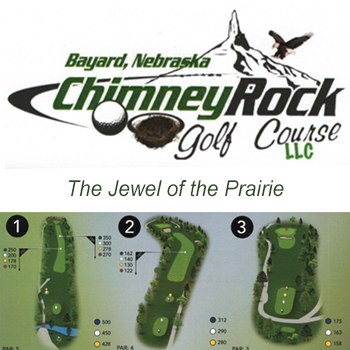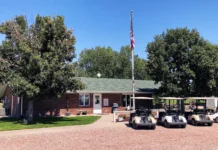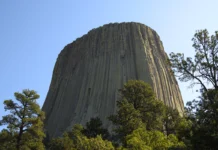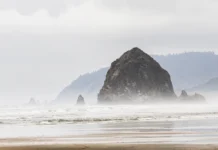| WYOMING |
Rising 100 feet above the North Platte River valley floor, near present-day Guernsey, Wyoming, stands the easternmost of three emigrant recording areas in Wyoming.
| REMNANTS OF A DREAM
Also known at various times as Sand Point Station and Register Rock, Register Cliff has been used as a campsite since at least the 1820s, when trappers and fur traders plied their trade in eastern Wyoming.
Although many of the older carvings have been worn away by time and erosion, one of the earliest legible inscriptions dates from 1829, when fur trappers and traders regularly passed through the area. It reads “1829 This July 14,” and was possibly carved by a French-speaking fur trapper to commemorate the French holiday of Bastille Day.
Later, as an estimated 500,000 emigrants traveled the Oregon, California, and Mormon trails from 1843-1869, pioneers, veterans of the Indian Wars, and other travelers carved their names and messages in the soft, chalky limestone.
The broad, grassy river bottoms in the shadow of the monolith provided an area to rest and gather strength as they camped on their first night west of the safety of Fort Laramie, Wyoming, before the push through rugged and nearly waterless terrain to the next major supply point on the trail, 368 miles west at Fort Bridger, Wyoming. An estimated 10% of pioneers died from accidents and disease along the way, and several of these unfortunate souls are buried in unmarked graves at the base of Register Cliff.
The most commonly found names of the 700 etched into the rock are from Ohio. One series of names represents three subsequent generations of travelers who visited Register Cliff over the years. T. H. Uthank was the first to engrave his name in the limestone, followed by O. N. Uthank in 1869 and O. A. Uthank in 1931.
During the heyday of the Oregon, California, and Mormon Trails, a small trading post was located at the base of the cliff. In 1861, it was turned into a short-lived Pony Express station and later a stage station.
In the 1870s, ranchers, and homesteaders began to settle in the area. In 1881, Charles A. Guernsey established a cattle ranch called the Guernsey Cattle Company, with its distinctive 999 Brand, at the base of Register Cliff. In 1926, the Frederick family assumed property ownership and continued to ranch in the area. They later donated the site to the state of Wyoming to be preserved as a memorial to the indomitable spirit of the pioneers. It was placed on the National Register of Historic Places on April 3rd, 1970.
Today, Register Cliff is accessible by traveling 3 mi—South on S. Wyoming Ave. from US Highway 26 and taking exit 92. Due to unmarked pioneer graves at the base of the escarpment and damage by modern-era vandals carving their names into the rock, the site is protected by a chain link fence. Be sure to bring a camera with a zoom lens to get the best possible views of the signatures and messages carved into the limestone.
| HISTORY CARVED IN SOFT STONE
Two miles from Register Cliff, the Oregon-California Trail leads away from the North Platte River and across a soft sandstone ridge. The rugged geography of the surrounding area forced virtually every westbound wagon to cross in the same spot, eventually wearing a track over five feet into the earth that can still be seen today.
The Oregon Trail Ruts, also called the Guernsey Ruts or Deep Rut Hill, are some of the most spectacular evidence in WyoBraska of the great westward overland migration from 1843 to 1869. The site was declared a National Historic Landmark in 1966 and is part of Guernsey State Park. Just a short walk from the parking area, visitors can stand in the tracks made by hundreds of thousands of hooves and iron-shod wagon wheels and imagine what it would be like to attempt to travel the route, which was first recorded by fur traders in 1812. A small picnic shelter is available, as well as public restrooms. The site is open year-round from sunrise to sunset.
A scant 0.3 miles from the Guernsey Ruts, at the Women Pioneers of the Oregon Trail memorial, lies the grave of Lucindy Rollins. Also called Lucinda Rollins, this brave pioneer began her journey from Dayton, Ohio in early 1849. Sadly, her voyage ended at this picturesque spot overlooking the North Platte River in June of that year. Little is known about her life, but it’s believed that she was attempting to become one of the 100,000 homesteaders and gold seekers who became residents of California in 1849, the start of the gold rush in American history.
Her original grave marker was vandalized and thrown into the river sometime before 1934 when it was replaced with a white marble obelisk and a plaque by the Historical Landmark Commission of Wyoming. Her memorial is easily accessible by turning west from South Guernsey Road onto Lucinda Williams Road and following the river a short distance to Lucindy’s final resting place.
| CREDITS & RESEARCH
Story by: Kathrine Rupe
Photography by: Hawk Buckman

































